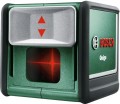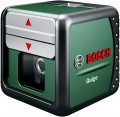Measurement range
The range at which the device remains fully operational without the use of additional receivers (see below); in other words, the radius of its action without auxiliary devices.
In some models, a range may be specified that shows the minimum (
3 cm,
5 cm) and maximum measurement ranges. But in most cases, only the maximum value is indicated.
The specific meaning of this parameter is determined by the type of instrument (see above). So, for optical levels, the measurement range is the greatest distance at which the operator can normally see the divisions of a standard leveling staff. For laser levels, this parameter determines the distance from the device to the surface on which the mark is projected, at which this projection will be easily visible to the naked eye; and in rangefinders we are talking about the greatest distance that can be measured. Typically, the measurement range is indicated for ideal conditions - in particular, in the absence of impurities in the air; in practice, it may be less due to dust, fog, or vice versa, bright sunlight "overlapping" the mark. At the same time, tools of the same type can be compared according to this characteristic.
Note that it is worth choosing a device according to the range of action, taking into account the features of the tasks that are planned to be solved with its help: after all, a large measurement range usually significa
...ntly affects the dimensions, weight, power consumption and price, but it is far from always required. For example, it hardly makes sense to look for a powerful laser level at 30-40 m if you need a device for finishing work in standard apartments.Operating temperature
The temperature range at which the device is guaranteed to work for a sufficiently long time without failures, breakdowns and exceeding the measurement error specified in the characteristics. Note that we are talking primarily about the temperature of the device case, and it depends not only on the ambient temperature — for example, a tool left in the sun can overheat even in fairly cool weather.
In general, you should pay attention to this parameter when you are looking for a model for working outdoors, in unheated rooms and other places with conditions that are significantly different from indoor ones; in the first case, it makes sense to also make sure that there is dust and water protection (see "Protection class"). On the other hand, even relatively simple and "myopic" levels / rangefinders usually tolerate both heat and cold quite well.
Operating time
Operating time of the device on one battery charge.
It is worth considering that these figures are quite approximate, since the operating time is measured under certain standard conditions (usually continuous operation at nominal power). And since in practice conditions may differ markedly, the operating time may turn out to be noticeably shorter or longer than stated. In addition, if the device uses replaceable batteries (AAA, AA and the like), then autonomy will also depend on the quality of the specific batteries/accumulators. Nevertheless, based on the data specified in the characteristics, it is quite possible to evaluate the capabilities of specific models and compare them with each other: the difference in the declared operating time, as a rule, proportionally corresponds to the difference in practical autonomy under the same conditions.
We also note that the operating time is specified mainly for levels; in rangefinders another parameter is more often used - the number of measurements (see below).
In box
—
holder. Devices for fixing the level / range finder on various surfaces. Such a device differs from a tripod primarily in its small size — within a couple of tens of centimeters. On the other hand, most holders allow you to install the device not only on horizontal, but also on vertical surfaces — for example, walls (and some are exclusively wall-mounted). Anyway, this function greatly expands the installation possibilities.
—
Receiver. laser radiation supplied with the device. This device is usually equipped with laser levels, less often with rangefinders, and it is not required at all for optical instruments. The main purpose of the receiver is situations where the laser mark is not visible to the naked eye — for example, at a long distance or in bright light. More details on the features of its application are described above in the paragraph “Measurement range (with receiver)”.
—
Tripod. Most modern instruments have a standard size thread and can be used with any suitable tripod. On the other hand, a complete tripod is most often specially designed for a certain model and optimally matches it in terms of general characteristics. In addition, this configuration option relieves you of the need to look for and purchase a suitable tripod yourself.
—
Case / case. The main function of these devices is to protect
...the device from bumps, scratches, dirt, temperature changes and other adverse effects; for this, of course, improvised means can also be used, but specialized protection is usually both more convenient and more reliable. In addition, almost all cases and most covers greatly simplify the transportation of the tool — in particular, due to the fact that they can also be used for complete accessories.
— Remote control. Among rangefinders and optical levels, this function is practically not found, because. working with them involves the constant stay of the device in the hands of the operator. But for laser levels that require you to regularly move from the device to the surface to be marked and back, the remote control can be a very useful addition — due to the fact that it minimizes such movements. For example, after marking the "front of work" on the wall according to the projection from the level, you do not have to approach the device to turn it off — just give a command from the remote control. At short distances, the savings in time and effort may not be so obvious, but over large areas, they can become quite noticeable.
